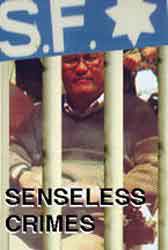 |
|
by Leroy Moore This is my third article on the increase of racial attacks, police I grabbed the inside pole, fearing that if he pulled me off the bus, it As I sat down, tears came to my eyes. The man's girlfriend had been the only one who tried to stop him, and not one other person on the bus spoke up. The driver closed the doors and continued on her route. I escaped that attack with only two deep scars on my neck, a broken bag and a new outlook on how I am an easy target because of my physical disability. I also thought about my disabled brothers and sisters who are not alive today because of racial attacks and police brutality. Recently I've been keeping a list of incidents of police brutality, racial attacks and other senseless crimes towards disabled people of color, and every day this list grows like a weed. The latest case brought tears to my eyes when I read it in the San Francisco Bayview Newspaper. A 13-year-old African-American boy with cerebral palsy was approached by two white teens during class. They asked him if they could tie him up. The boy firmly said,"No," but the two teens proceeded to tie him up and then placed a noose around his neck,and joked about tossing the rope over a pipe to hang him. What is even more shocking is the teacher witnessed the thirty-minute ordeal and did nothing. The boy's mother was quoted as saying "If my son was white, everybody in Texas would know about his case." This comment tells me that when you add race to the picture, it becomes even harder to one's your case. My list of crimes towards disabled people of color is so hard to research because, until recently, the disability was not reported when a person with a disability was a victim of a hate crime. Many leaders in the disability rights movement refuse to talk about this issue, especially when it comes to disabled people of color, and so it goes unnoticed. Almost five years ago Kathi Wolf authored an article entitled "Bashing the Disabled:the New Hate Crime" in The Progressive. The article reported that the Hate Crimes Statistics Act was amended to include bias on disability. The FBI has collected data about disability-based hate crimes, as well as those based on race, ethnicity, religion and sexual orientation. In this same article, Mr. James Nolan, a coordinator of the FBI hate-crimes programs, said that his department will work with disability groups to understand and identify hate crimes, and will also work with police departments and law-enforcement agencies to make them more knowledgable and sensitive about disability issues. Now, five years later, we have many documented cases of police brutality and hate-crimes against disabled people of color. For example a recently published book 1997: shooting and killing of Kelvin Robinson, a Black deaf man who was shot three times in the back by LAPD and bled to death because the officers refused to call the paramedics. April of 1998: an Ethiopian man in Maryland was shot and killed by officer George Byce, a White cop with a history of racism and hostility toward mentally impaired people. Last year Magaret L. Mitchell, a Black homeless woman with mental illness, was shot to death by a LA police officer. Many people are surprised when I tell them that James Byrd, the Black man who was dragged to his death behind a truck in Texas, had a disability! According to an LA Times study last year, since 1994 LA police officers have shot 37 individuals who had some symptoms of mental illness. Many were people of color. The study also found that LA police recruits receive only four hours of training on how to deal with people with mental illness. On June 21, 2000, the San Francisco Chronicle ran an article entitled "Senate Okay's Broader Hate Laws." The Senate voted on June 20th to strengthen federal hate-crime laws by extending civil rights era protections, for the first time, to include violence based on gender, sexual orientation and disabilities, but it's hurdle is in the House. If the Bill becomes law, it will provide the first major expansion of hate-crime law since the original bill that was passed in 1968, which covers only crimes involving race, color, religion or national origin. Although this expansion will include people with disabilities, the real voices behind this Bill are gays and lesbians, not people with disabilities. The same article mentioned James Bryd, but did not identify his disability as part of his identity, and the article also talked about Matthew Shepard, a gay college student who died after being beaten into a coma and tied to a fence. The article did not identify a disabled victim of a hate-crime. I have many questions regarding the inclusion of people with disabilities when it comes to hate-crimes, but one sticks out to me. Why are the feds giving local authorities grants to help them deal with these crimes? A Have disabled organizations voiced their opinion and advocated on hate crimes since 1995? My research on this issue has mainly come my way via mainstream media and the ethnic press, not through disabled organizations. With the silence of the disabled community and local authorities inadequately training themselves on hate-crimes dealing with people with disabilities, no wonder things are worse since the Kathi Wolfe article of 1995. Reva Trevino, of the Los Angeles County of Commission on Human Relations Network Against Hate Crimes, was quoted in the Wolfe article. He said that while it is well organized on other concerns, the disability community hasn't yet organized around the issue of hate-crimes. It is the year 2000 and Trevino's words are still true. Five years later By Leroy F. Moore Jr., Founder of Disability Advocates of (415) 695-0153 |
Original Post Date
2000-01-01 12:00 AM
Original Body



